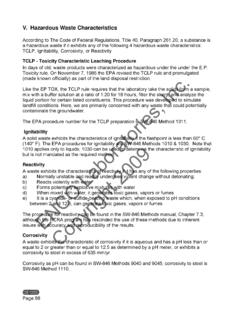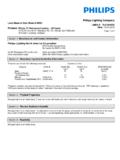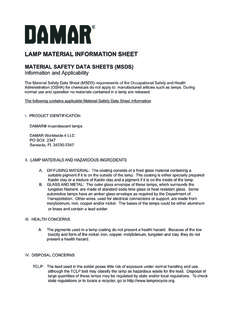Transcription of TCLP EPA 1311 vs. SPLP EPA 1312 Which Is The Correct ...
1 tclp EPA 1311 vs. SPLP EPA 1312 Which Is The Correct choice For My Application tclp analysis by EPA 1311 is a leaching procedure designed to replicate the leaching of contaminants in municipal landfills due to typical municipal landfill leachates. In contrast SPLP. analysis by EPA 1312 is designed to mimic the leaching of contaminants exposed to normal weathering in situ by acid rain. tclp extractions are often misapplied. tclp is the acronym for Toxicity Characteristics Leaching Procedure. This methodology was developed to estimate the mobility of specific inorganic and organic contaminates that are destined for disposal in municipal tclp extraction is performed by subjecting the material to be tetsed to a simulated landfill leachate.
2 Acetic acid was chosen as the extraction fluid because it is the major component of typical municipal landfill leachates. The pH of the acetic acid buffer solution is maintained at This sample/acetic acid mixture is subjected to an 18 ( 2 hours) rotary extraction, designed to accelerate years of material/landfill exposure in the shortest possible time. After extraction, the resulting liquid can be subjected to analysis utilizing a list of 39 contaminants that are contained in the EPA's tclp Final Rule. These contaminants include eight metals, eleven volatile organic compounds, twelve semi-volatile organic compounds, six pesticides, and two herbicides.
3 tclp Rotary extractor used to spin samples for 18 hours Consequently, the tclp test should be limited to determining if a waste should be considered a RCRA-regulated waste or, if it can be disposed of in a municipal (sanitary) landfill. The tclp . procedure may be misapplied in two ways. First, analysis of compounds not included in the methods development or tclp Final Rule may provide technically invalid results. An example of this would be the utilization of the tclp extraction for cyanide. The extraction procedure itself will result in the loss of simple cyanide complexes, representing the most toxic form of cyanide. The second way the tclp is misapplied is by use of the procedure for materials that are not destined for landfills where interaction with acetic acid is unlikely.
4 In these cases an alternative procedure, the SPLP, (Synthetic Precipitation Leaching Procedure) EPA SW-846 Method 1312 . may be appropriate. This procedure is applicable for materials where the leaching potential due to normal rainfall is to be determined. Instead of the landfill leachate simulating acetic acid mixture, nitric and sulfuric acids are utilized in an effort to simulate the acid rains resulting from airborne nitric and sulfuric oxides. The SPLP procedure is useful in those situations where a determination must be made if a potentially contaminated material, left in situ, will leach toxic substances when exposed to normal weathering.

![FERERAL [RCRA-TCLP] AND STATE [TITLE 22-STLC, TTLC ...](/cache/preview/f/1/2/2/d/2/9/c/thumb-f122d29cd25cb54e2601a0dcadd552fd.jpg)





